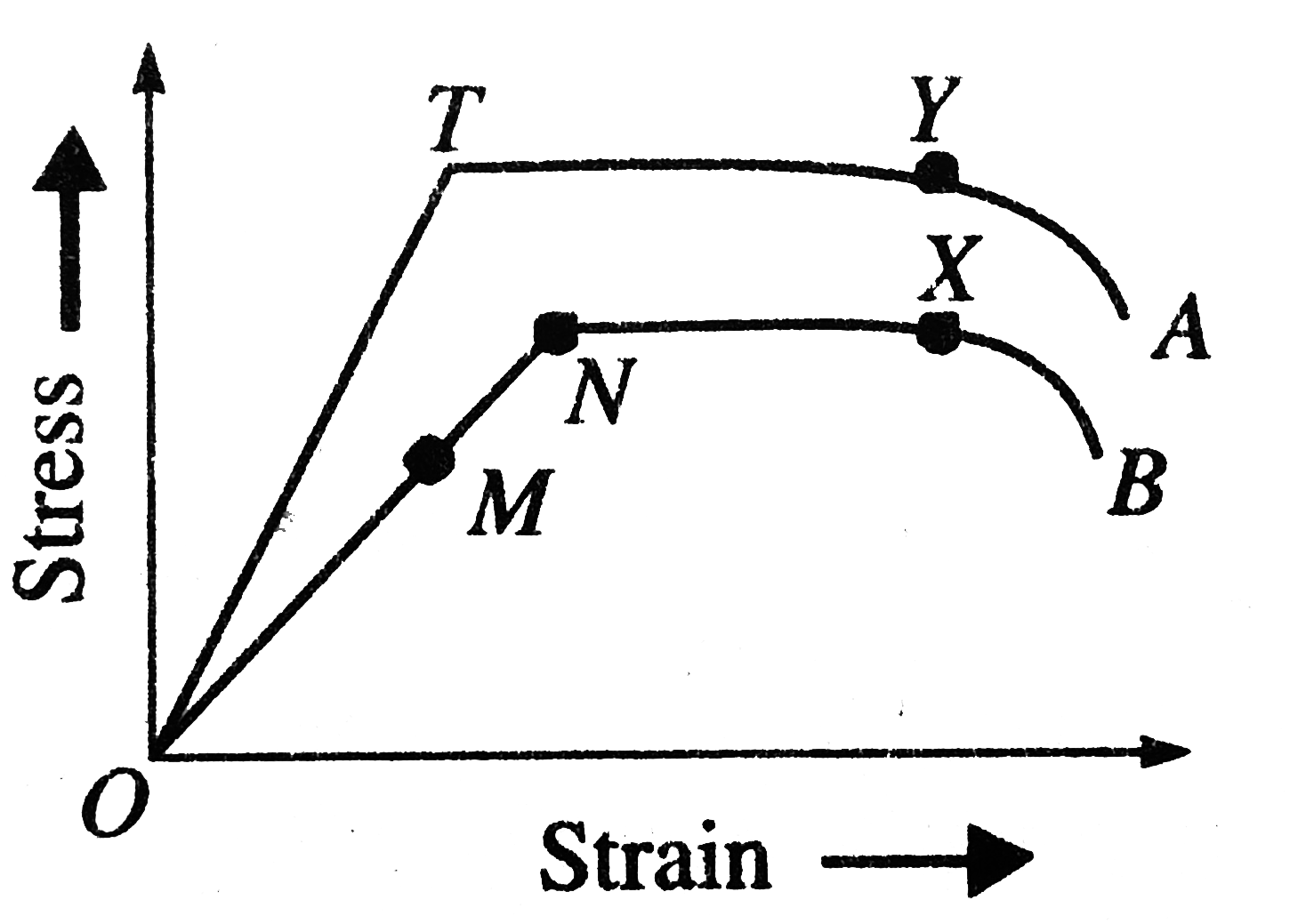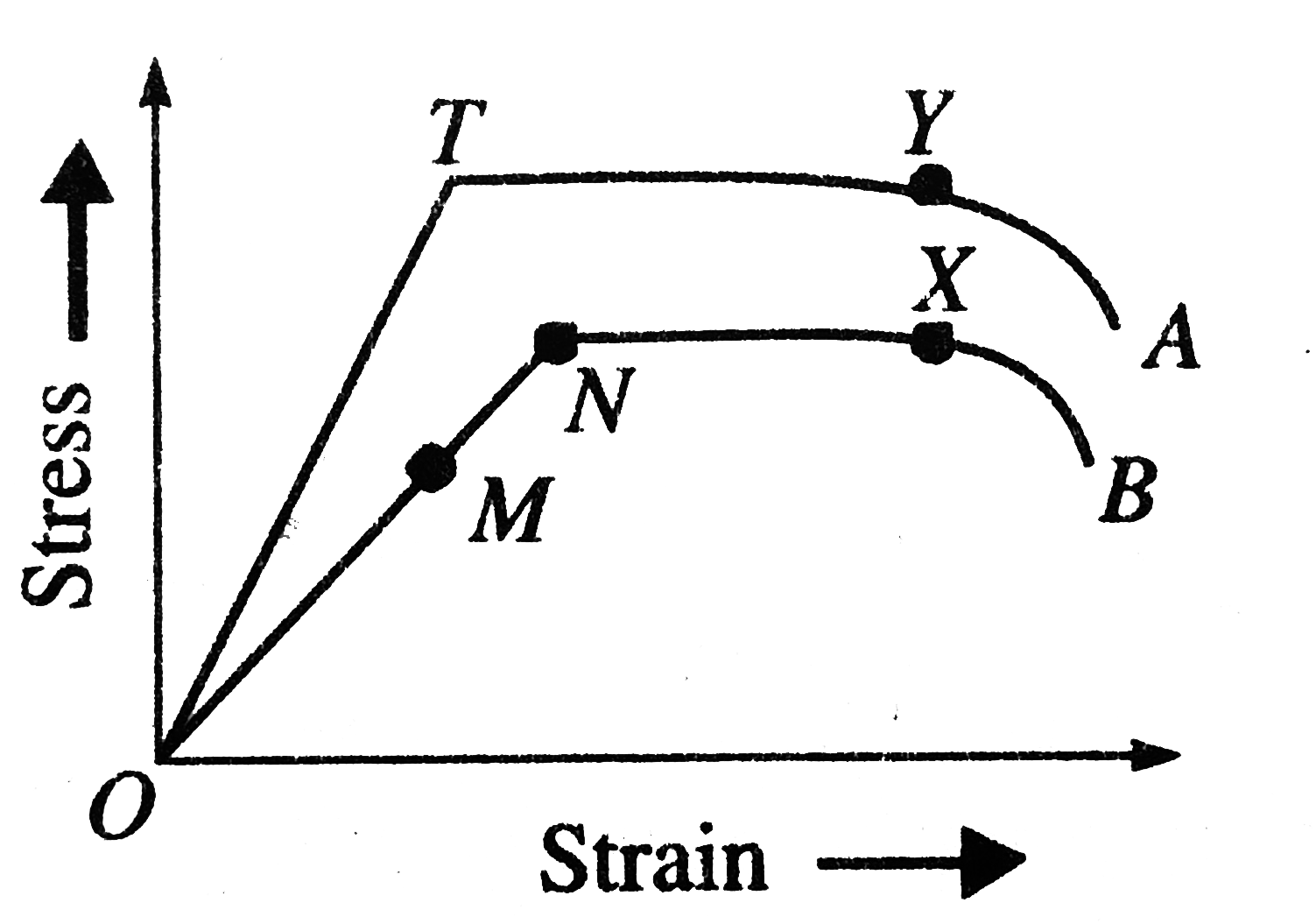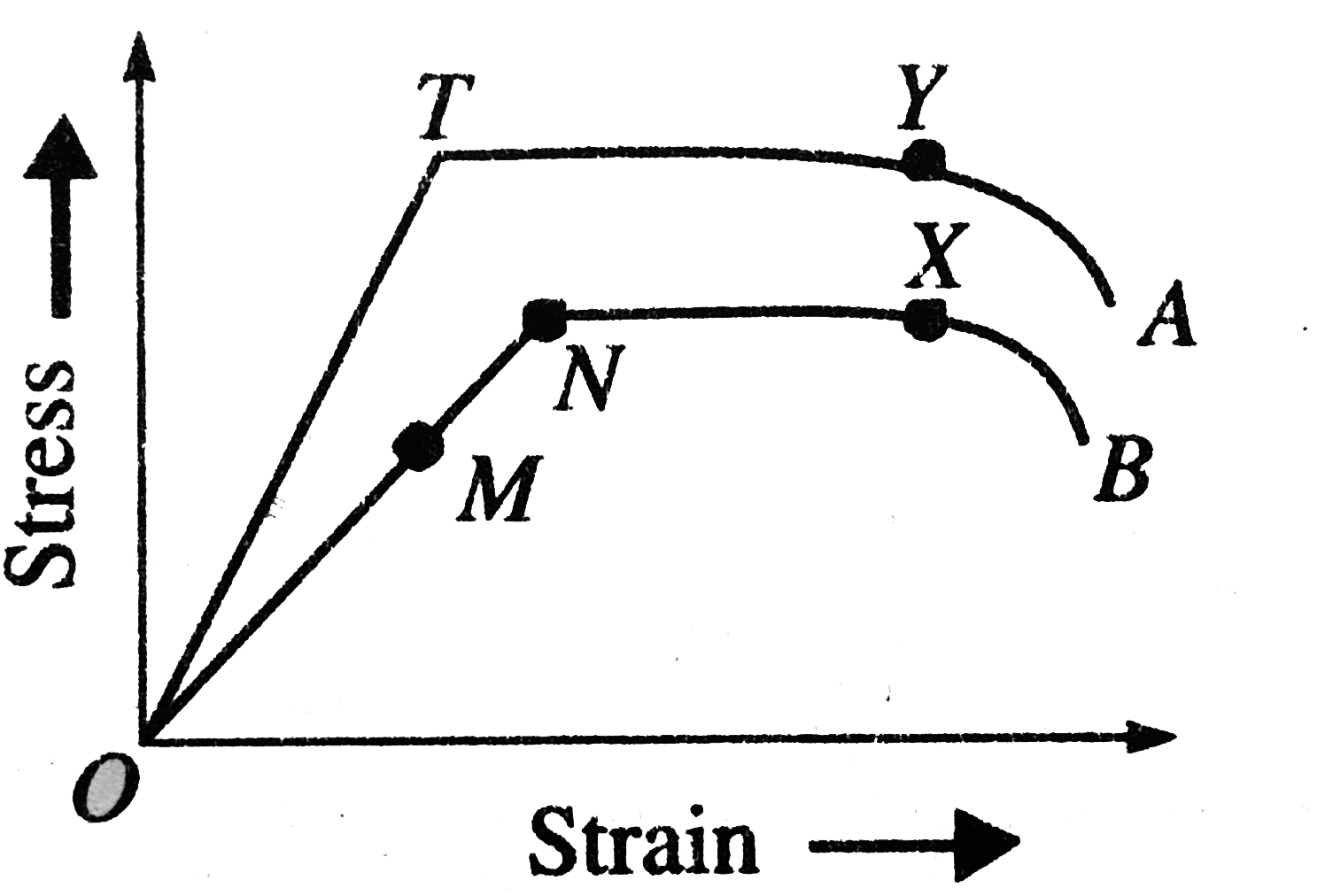Assertion : If we apply force to a lump of putty or mud, they have no gross tendency to regain their previous shape.
Reason : This type of substances are called plastic substances.
The correct Answer is:A
To solve the question, we need to analyze both the assertion and the reason provided.
1. Understanding the Assertion:
- The assertion states that when a force is applied to a lump of putty or mud, they do not tend to regain their original shape after the force is removed.
- This indicates that these materials undergo a permanent deformation when subjected to stress.
2. Analyzing the Reason:
- The reason given is that such substances are classified as plastic substances.
- Plastic substances are defined as materials that, when deformed, do not return to their original shape after the removal of the applied force.
3. Connecting Assertion and Reason:
- The assertion is a specific observation about the behavior of putty and mud, while the reason provides a general classification of such behavior as plasticity.
- Since the assertion correctly describes the behavior of putty and mud, and the reason explains why this behavior occurs (i.e., they are plastic substances), both statements are true.
4. Conclusion:
- Since both the assertion and the reason are true, and the reason correctly explains the assertion, we conclude that the correct answer is that both the assertion and reason are true, and the reason is the correct explanation of the assertion.
Final Answer:
Both assertion and reason are true, and the reason is the correct explanation of the assertion.
- The assertion states that when a force is applied to a lump of putty or mud, they do not tend to regain their original shape after the force is removed.
- This indicates that these materials undergo a permanent deformation when subjected to stress.
- The reason given is that such substances are classified as plastic substances.
- Plastic substances are defined as materials that, when deformed, do not return to their original shape after the removal of the applied force.
- The assertion is a specific observation about the behavior of putty and mud, while the reason provides a general classification of such behavior as plasticity.
- Since the assertion correctly describes the behavior of putty and mud, and the reason explains why this behavior occurs (i.e., they are plastic substances), both statements are true.
- Since both the assertion and the reason are true, and the reason correctly explains the assertion, we conclude that the correct answer is that both the assertion and reason are true, and the reason is the correct explanation of the assertion.
Both assertion and reason are true, and the reason is the correct explanation of the assertion.
Topper's Solved these Questions
- MECHANICAL PROPERTIES OF SOLIDSBOOK - NCERT FINGERTPS ENGLISHCHAPTER - MECHANICAL PROPERTIES OF SOLIDSEXERCISE - Hooke'S Law
3 Videos
- MECHANICAL PROPERTIES OF SOLIDSBOOK - NCERT FINGERTPS ENGLISHCHAPTER - MECHANICAL PROPERTIES OF SOLIDSEXERCISE - Higher Order Thinking Skills
8 Videos
- MECHANICAL PROPERTIES OF SOLIDSBOOK - NCERT FINGERTPS ENGLISHCHAPTER - MECHANICAL PROPERTIES OF SOLIDSEXERCISE - NCERT
8 Videos
- MECHANICAL PROPERTIES OF FLUIDSBOOK - NCERT FINGERTPS ENGLISHCHAPTER - MECHANICAL PROPERTIES OF FLUIDSEXERCISE - NCERT Exemplar
5 Videos
- MOTION IN A PLANE BOOK - NCERT FINGERTPS ENGLISHCHAPTER - MOTION IN A PLANE EXERCISE - Assertion And Reason
15 Videos
Similar Questions
Knowledge Check
Assertion : The ability of a material to permit the passage of magnetic lines of force through it is called magnetic permeability.
Reason: For a perfect diamagnetic substance, permeability is always one.AIf both assertion and reason are true and reason is the correct explanation of assertion.BIf both assertion and reason are true and reason is not the correct explanation of assertion.CIf assertion is ture but reason is false.DIf both assertion and reason are false.Assertion: Paramagnetic substances get weakly attracted to a magnet.
Reason: They have tedency to from a region of strong magNetic field to weak magnetic Held.AIf both assertion and reason are true and reason is the correct explanation of assertion.BIf both assertion and reason are true and reason is not the correct explanation of assertion.CIf assertion is ture but reason is false.DIf both assertion and reason are false.Assertion:At low temperature , particles of matter occupy fixed positions and exist in solid state.
Reason : Under a given set of conditions of temperature and pressure , the state of a substance depends upon the net effect of thermal energy and intermolecular forces.AIf both assertion and reason are true and reason is the correct explanation of assertionBIf both assertion and reason are true but reason is not the correct explanation of assertion.CIf assertion is true but reason is falseDIf both assertion and reason are false
Materials get deformed when force is applied. Some of them regain their status when the applied force is removed. They are termed as elastic. Those of which not regaining are called plastic. There may be delay in the regaining in some materials. They are said to have got elastic aftereffect, since they have gone beyond the elastic limit. Repeated application and removal of force leads to fatigueness in the material. Fatigued materials may break at any point time and so are avoided.
The stress strain graph for two materials A and B is shown in the following figure:

The strength of the material A and B is SA and SB, respectively, while the longevity of plastic behaviour is LA and LB. Then
View SolutionMaterials get deformed when force is applied. Some of them regain their status when the applied force is removed. They are termed as elastic. Those of which not regaining are called plastic. There may be delay in the regaining in some materials. They are said to have got elastic aftereffect, since they have gone beyond the elastic limit. Repeated application and removal of force leads to fatigueness in the material. Fatigued materials may break at any point time and so are avoided.
The stress strain graph for two materials A and B is shown in the following figure:

The time in which the two materials regain their original status is tA and tB related as tB=2tB. Then the material under elastic aftereffect (relatively) is
View SolutionAssertion: The mass of a substance is constant whereas its weight may vary from one place to another.
Reason : Mass of a substance is the amount of matter present in it while weight is the force exerted by gravity on an object.
View SolutionMaterials get deformed when force is applied. Some of them regain their status when the applied force is removed. They are termed as elastic. Those of which not regaining are called plastic. There may be delay in the regaining in some materials. They are said to have got elastic aftereffect, since they have gone beyond the elastic limit. Repeated application and removal of force leads to fatigueness in the material. Fatigued materials may break at any point time and so are avoided.
The stress strain graph for two materials A and B is shown in the following figure:

If the intensity of A and B is EA and EB, respectively
View SolutionThe force of interaction between the molecules of same substance is called cohesive force hile force of interaction between molecules of different substances is called adhesive force . Both the forces are attracive and have a range of about 10 A . If we consider a molecule . A well inside a liquid we find that it is equally attracted by the surrounding molecules in all the directions ( with a sphere of radius 10 Å ) and so it does not experience any resultant force . On or near the surface of a liquid , the molecules do not exist on the free side and so a molecule ( say B ) experiences a resultant force vertically downwards into the liquid . For this reason , the molecules of the surface have a tendency to go into the liquid . Thus , the surface tends to contract and gives rise to surface tension .
As surface molecules like B experience a net downward force of cohension and have tendency to go down , so in increasing the area of the surface more molecules are to be shifted to the surface from inside . Thus , more mechnical work will have to be done against the net downward force of cohension . This work is stored by the molecules in the surfaces as potential energy called free surface energy .
Furthermore , molcules like P , in contact with the liquid will stick to the solid surface , i.e will meet it if the force of adhesion A is greater than net force of cohension C . The liquid will not the solid surface if C>A
Also , molecules like Q at the surface in contact with the solid will experience a net force of cohension CR . If adhesion A is greater then cohension CR , the resultant force will be F . As the liquid can't support tangential force , F must be perpendicular to the surface of the liquid . So , the menisus will be concave and the angle of contact will be acute (>90∘) . However , if adhesion is lesser than cohension , the resultant force F will be directed into the liquid and so the menisus ( which is perpendicular to F as liquid support tangential force ) will be convex and the angle of contact will be obtuse (>90∘)

A liquid particle B , which is present in the vicinity particle A can exert a force on A if the distance of B from A is
View Solution
